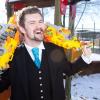- NerfHaven
- → Viewing Profile: Topics: udsaxman
udsaxman
Member Since 17 May 2016Offline Last Active Oct 13 2016 09:06 PM
Community Stats
- Group Members
- Active Posts 10
- Profile Views 5,171
- Member Title Member
- Age 42 years old
- Birthday October 26, 1983
User Tools
Latest Visitors
Topics I've Started
Nerf vacuum cannon
01 August 2016 - 09:12 PM
I'm shooting for Mach 0.5 if I can pull a good enough vacuum and fit it in my Jeep so I'm aware that 500 fps darts are WAY beyond anything I could use during a war so this will be an exhibition peice.
Thoughts/comments/horror stories?
How to control a blaster with Arduino
24 May 2016 - 05:57 PM
I thought I would share some code I have cobbled together for controlling my brushless Stryfe with an arduino controller. This allows for push button spin-up and you don't need to use a servo tester to control the motors which is always good. Any suggestions are always welcome. There is code included that allows you to hook a servo up to feed ammo into the flywheels for those of you who want to replace the pusher motors in your rapidstrikes with a servo. ![]()
Feel free to modify this like crazy and do all sorts of strange things with it. This can be easily incorporated into ammo counters as well to have a single controller do both (any Arduino board is more than powerful enough to not blink at the task).
Latest version of code can always be found here: https://github.com/u...er/ArduNerf.ino
Code as of now:
//Arduino program to control a nerf blaster with brushless flywheels and a servo for feeding darts into the flywheels
//The pushbuttons I'm using in this example are OSEPP Push Button Modules http://osepp.com/pro...-button-module/
//Arduino controller used during this development is an Intel Curie powered Arduino 101 https://www.arduino....ArduinoBoard101with an OSEPP SensorShield on top of it http://osepp.com/products/shield-arduino-compatible/sensor-shield/. You will need to use OPTO ESCs and a seperate power feed for this setup!
//Also tested wih an ATMEGA2560 based Multiwii Flight Controller i had laying around http://www.readytoflyquads.com/multiwii-pro-2-0-flight-controller. To use this you will need to make sure one of your ESCs has a BEC built in.
//ESCs utilized here are http://www.hobbyking..._Firmware_.html.
#include <Servo.h> //nice and simple, we are only utilizing one library for this project. Servo handles everything we need it to
//declare servo objects that will be used throughout the rest of the project.
Servo ESC1;
Servo ESC2;
Servo feedServo;
//arm esc
// constants won't change. They're used here to
// set pin numbers:
const int spinButtonPin = 8; // the number of the pin where the spin button is connected
const int feedButtonPin = 7; // the number of the pin where the feed button is connected
const int ledPin = 13; // the number of the LED pin
const int ESC1Pin = 5; //piuninumber of the first ESC
const int ESC2Pin = 6; //pin number of the second ESC
const int feedServoPin=9; //pin number for the servo that will be pushing darts into the flywheels
// Variables will change:
int ledState = LOW; // the current state of the output pin
int spinButtonState; // used for storing the current reading from the spin input pin
int feedButtonState; // used for storing the current reading from the feed input pin
int lastSpinButtonState = HIGH; // the previous reading from the spin input pin - we instantiate it to the non-firing position to start the program
int lastFeedButtonState = HIGH; // the previous reading from the feed input pin - we instantiate it to the non-firing position to start the program
//if not all your ESCs are the same, you may need an additonal variable but that shouldnt be necessary here.
int ESCMinSpeed = 1000; //this varies by ESC. Min speed must be low enough to arm. Refer to speec controller's documentation for this
int ESCMaxSpeed = 1800; //this varries by ESC. You may want to set it slightly lower than the max supported to avoid overheating issues
void setup() {
//setup the pins so we can use them for reading the button state.
pinMode(spinButtonPin, INPUT);
pinMode(feedButtonPin, INPUT);
//set ledPin to output power to the LED
pinMode(ledPin, OUTPUT);
//set initial LED state
digitalWrite(ledPin, ledState);
//attach servos
ESC1.attach(ESC1Pin);
ESC2.attach(ESC2Pin);
feedServo.attach(feedServoPin);
//write minimum speed to ESCs so they arm
ESC1.writeMicroseconds(ESCMinSpeed);
ESC2.writeMicroseconds(ESCMinSpeed);
//wait 1 second for ESCs to arm
delay(1000);
}
void loop() {
// read the state of the switchs into a local variable:
int spinReading = digitalRead(spinButtonPin);
int feedReading = digitalRead(feedButtonPin);
// check to see if you just pressed the button
//only change speed if button state has changed
if (spinReading != lastSpinButtonState) {
if (spinReading == LOW) {
ledState = HIGH;
ESC1.writeMicroseconds(ESCMaxSpeed);
ESC2.writeMicroseconds(ESCMaxSpeed);
}
if (spinReading == HIGH) {
ledState = LOW;
ESC1.writeMicroseconds(ESCMinSpeed);
ESC2.writeMicroseconds(ESCMinSpeed);
}
}
//if feed button has been pressed, start pushing darts out
//What you write to the servos will vary greatly depending how you setup the feed mechanism.
//This example has the servo pushing a dart in when you push the button and then moving back to get ready to push the next one when yo let up on it.
//In a rapidstrike or similar, you can just set ti to keep spinning while the button is pressed
if (feedReading != lastFeedButtonState) {
//if button is pressed, feed a dart in
if (feedReading == LOW) {
feedServo.write(180); //writes the server to full rotation
}
//return servo to the withdrawn state when button is released
if (feedReading == HIGH) {
feedServo.write(0);
}
}
// save the reading. Next time through the loop,
// it'll be the lastButtonState:
lastSpinButtonState = spinReading;
lastFeedButtonState = feedReading;
// set the LED:
digitalWrite(ledPin, ledState);
}
I attempted to attach the .ino file but the forums don't seem to be a big fan
- NerfHaven
- → Viewing Profile: Topics: udsaxman
- Terms of Service and Privacy Policy
- Code of Conduct ·



 Find content
Find content



